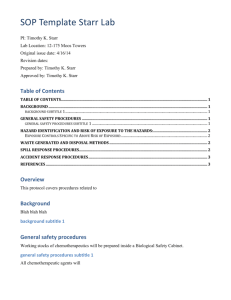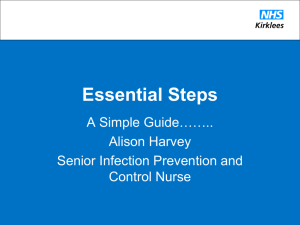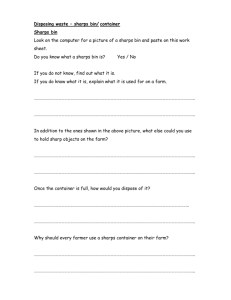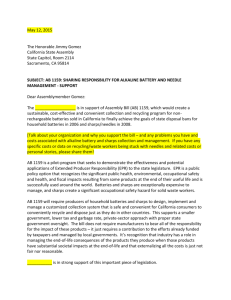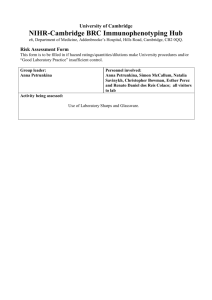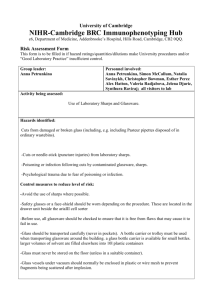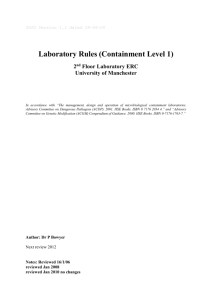Sample Biological Material Standard Operating Procedure
advertisement
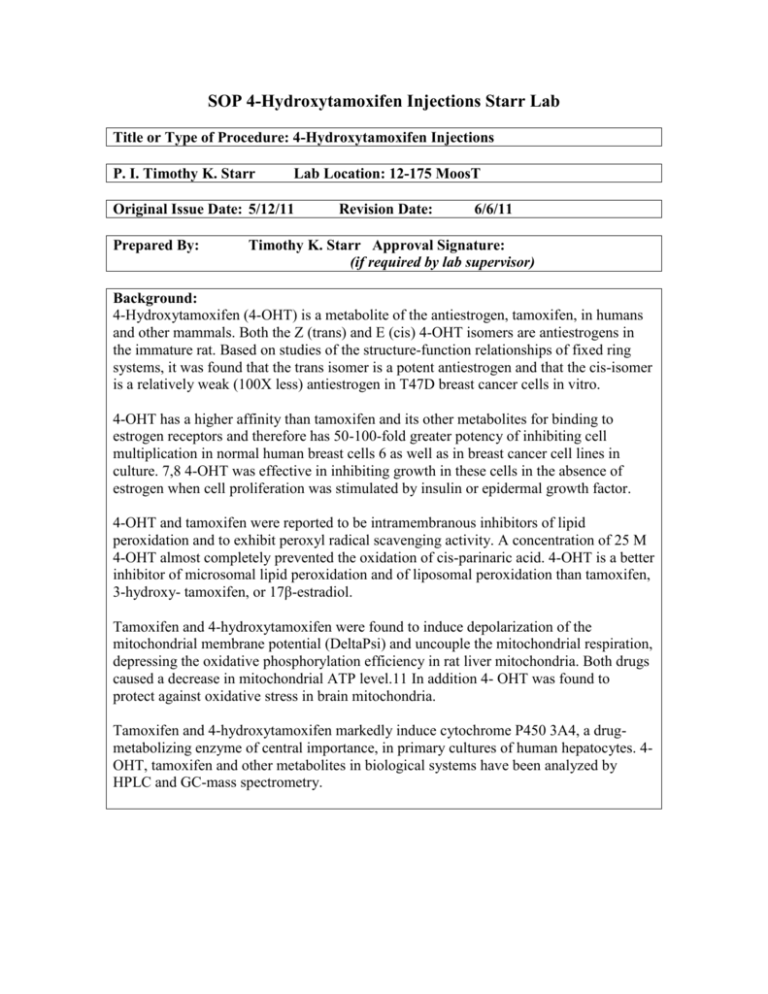
SOP 4-Hydroxytamoxifen Injections Starr Lab Title or Type of Procedure: 4-Hydroxytamoxifen Injections P. I. Timothy K. Starr Lab Location: 12-175 MoosT Original Issue Date: 5/12/11 Prepared By: Revision Date: 6/6/11 Timothy K. Starr Approval Signature: (if required by lab supervisor) Background: 4-Hydroxytamoxifen (4-OHT) is a metabolite of the antiestrogen, tamoxifen, in humans and other mammals. Both the Z (trans) and E (cis) 4-OHT isomers are antiestrogens in the immature rat. Based on studies of the structure-function relationships of fixed ring systems, it was found that the trans isomer is a potent antiestrogen and that the cis-isomer is a relatively weak (100X less) antiestrogen in T47D breast cancer cells in vitro. 4-OHT has a higher affinity than tamoxifen and its other metabolites for binding to estrogen receptors and therefore has 50-100-fold greater potency of inhibiting cell multiplication in normal human breast cells 6 as well as in breast cancer cell lines in culture. 7,8 4-OHT was effective in inhibiting growth in these cells in the absence of estrogen when cell proliferation was stimulated by insulin or epidermal growth factor. 4-OHT and tamoxifen were reported to be intramembranous inhibitors of lipid peroxidation and to exhibit peroxyl radical scavenging activity. A concentration of 25 M 4-OHT almost completely prevented the oxidation of cis-parinaric acid. 4-OHT is a better inhibitor of microsomal lipid peroxidation and of liposomal peroxidation than tamoxifen, 3-hydroxy- tamoxifen, or 17β-estradiol. Tamoxifen and 4-hydroxytamoxifen were found to induce depolarization of the mitochondrial membrane potential (DeltaPsi) and uncouple the mitochondrial respiration, depressing the oxidative phosphorylation efficiency in rat liver mitochondria. Both drugs caused a decrease in mitochondrial ATP level.11 In addition 4- OHT was found to protect against oxidative stress in brain mitochondria. Tamoxifen and 4-hydroxytamoxifen markedly induce cytochrome P450 3A4, a drugmetabolizing enzyme of central importance, in primary cultures of human hepatocytes. 4OHT, tamoxifen and other metabolites in biological systems have been analyzed by HPLC and GC-mass spectrometry. Procedural Methods and Materials: General Safety Procedures: Working stocks of 4-hydroxytamoxifen will be prepared inside a Biological Safety Cabinet. Always were PPE including lab coat, gloves, face mask and eye goggles when handling and preparing 4-OHT stock solutions Preparation of 4-OHT stock Dissolve 5 mg of 4-OHT (H7904, Sigma) in 50µl ethanol and 450µl peanut oil, for a final concentration of 10 mg/ml. Sterilize by filtration through a 20 micron filter. Store at -20º C. Immediately before using either sonicate or place on shaker at 25ºC for 1 hour. Intra-peritoneal injection of 4-OHT Prepare working stock of 4-OHT by diluting stock solution 1:10 with sterile peanut oil. Load a 1 ml syringe (23 guage needle) with 100 µl working stock. Keep in sterile field. Hold mouse firmly: Place mouse on a rough surface while holding the tail firmly (Note: Smooth surfaces will frighten the mouse because it cannot get a foothold. This may cause it to turn around and try to bite in its attempt to escape.) Grasp the nape gently and firmly with your free hand and lift the mouse. Place the mouse's tail between the last two fingers of the hand that is holding the nape. Insert needle 10 mm ventral to hip joint. Insert needle through skin/peritoneum into stomach cavity. Avoid nipples and keep needle close to skin to avoid perforating viscera. Inject 100 µl (0.1 mg 4-OHT). Repeat daily for a total of 5 consecutive days. Dispose of needles immediately in sharps containers. Hazard Identification and Risk of Exposure to the Hazards: Sharps, especially needles used for injection. Never recap needles, but place directly in Sharps container. Exposure to 4-Hydroxytamoxifen OSHA Hazards Target Organ Effect, Irritant Target Organs: Reproductive system., Central nervous system, Liver GHS Classification Acute toxicity, Inhalation (Category 4) Acute toxicity, Dermal (Category 4) Acute toxicity, Oral (Category 4) Reproductive toxicity (Category 2) NFPA Rating Health hazard: Warning: Harmful if swallowed or in contact with skin. Harmful if inhaled. Suspected of damaging fertility or the unborn child. Wear protective gloves/ protective clothing. May be harmful if inhaled. Causes respiratory tract irritation. May be harmful if absorbed through skin. Causes skin irritation. Causes eye irritation. May be harmful if swallowed. Exposure Controls Specific to Above Risk of Exposure: PPE - Lab coats, face shield, gloves, surgical mask and sharps containers. Use Biologic Safety Cabinet during preparation and handling of 4-OHT All sharps and glass waste will be disposed of in an approved hard plastic sharps container (U Stores # CX40245, MS07407 or similar), No Cardboard sharps pouches. If exposure to 4-OHT occurs: Consult a physician. Show the MSDS to the doctor in attendance. Move out of dangerous area. If breathed in, move person into fresh air. If not breathing, give artificial respiration. Consult a physician. In case of skin contact wash off with soap and plenty of water. Consult a physician. In case of eye contact flush eyes with water as a precaution. If swallowed never give anything by mouth to an unconscious person. Rinse mouth with water. Consult a physician. In case of accidental injection seek medical attention immediately. Waste Generated and Disposal Methods: 4-OHT is considered a hazardous chemical. Any unused 4-OHT that needs to be discarded should be placed in a properly labelled hazardous waste container and disposed of by the University of Minnesota Chemical Waste Facility (part of the Division of Environmental Health & Safety). Sharps containers will be sealed when ¾ full and placed in designated waste area. In addition to unused chemical waste, the following waste disposal measures should be followed: -Sharps contaminated with trace carcinogens or hazardous drugs must be disposed of in a separate sharps container that is labeled “4-OHT Sharps,” sealed, and placed in a yellow bag for incineration -Residual and trace chemotherapeutic wastes, such as completely empty delivery devices, gowns, gloves, tubing, etc., should be disposed of in yellow bags for incineration. -Bedding should be put in yellow bags for collection and managed as hazardous chemical waste (only while being treated with 4-OHT) The above information can be found at the following link: fhttp://www.dehs.umn.edu/PDFs/Chemo%20Waste%20Disposal%20fact%20sheet.pdf Spill and Accident Response Procedures: Clean up waste regularly and abnormal spills immediately. Avoid breathing dust and contact with skin and eyes. Wear protective clothing, gloves, safety glasses and dust respirator. Use dry clean up procedures and avoid generating dust. Vacuum up or sweep up. NOTE: Vacuum cleaner must be fitted with an exhaust micro filter (HEPA type) (consider explosion-proof machines designed to be grounded during storage and use). Dampen with water to prevent dusting before sweeping. Place in suitable containers for disposal. If in liquid form, wipe up with paper towel. When decomintaminating is finished carefully place any and all materials in appropriate bio hazard bin/bag or autoclave bag Only attempt to clean up very small powder and liquid spills (e.g., very small amounts spilled around a balance). In this situation, wear appropriate PPE as described, place wet paper towels over powder or use absorbant pads for liquid, and place all materials in leak proof container. ALL spill materials should be disposed of as hazardous waste through the U of M Chemical Waste Program. Larger spills should be immediately reported to DEHS for cleanup (612-626-6002). Notes: RAR Area Supervisor must be informed of your intent to use 4-OHT PI must train RAR staff on hazards and proper handling procedures Cages of animals injected with 4-OHT must be clearly labeled as such References: For further information view the UMN DEHS website containing Bio Basic Fact Sheets at http://www.dehs.umn.edu/bio_basicfacts.htm. For general information on Biosafety, access the Biosafety in Microbiological and Biomedical Laboratories (BMBL) 5th Edition from the CDC at BMBL http://www.cdc.gov/biosafety/publications/bmbl5/index.htm For Material Safety Data Sheets access the Public Health agency of Canada website MSDS http://www.phac-aspc.gc.ca/lab-bio/res/psds-ftss/index-eng.php. MSDS sheet for 4-hydroxytamoxifen: http://datasheets.scbt.com/sc-3542.pdf Background Information on 4-hydroxytamoxifen: http://www.sigmaaldrich.com/etc/medialib/docs/Sigma/Datasheet/2/h6278dat.Par.00 01.File.tmp/h6278dat.pdf
